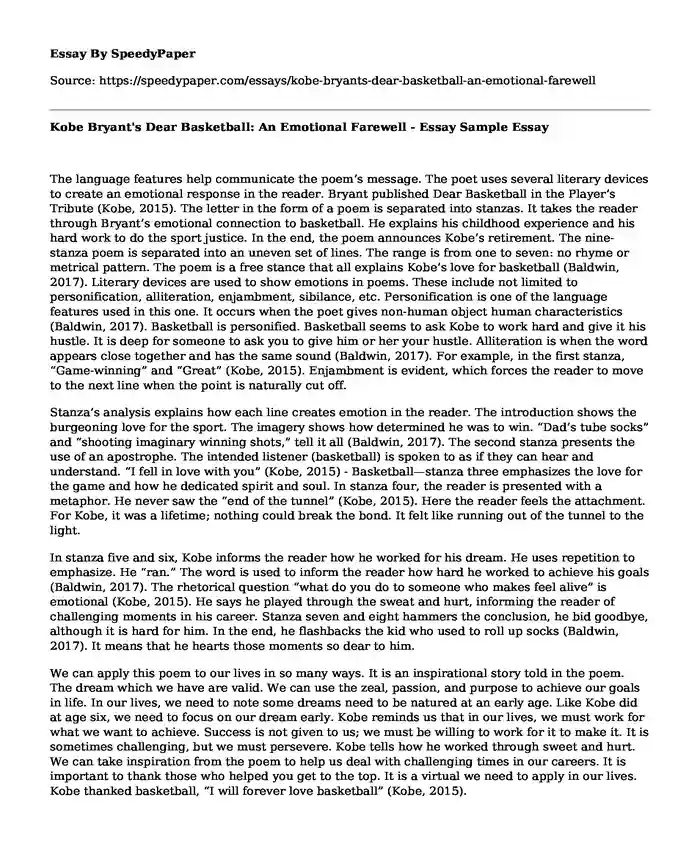
| Type of paper: | Essay |
| Categories: | Literature Languages |
| Pages: | 3 |
| Wordcount: | 731 words |
The language features help communicate the poem’s message. The poet uses several literary devices to create an emotional response in the reader. Bryant published Dear Basketball in the Player’s Tribute (Kobe, 2015). The letter in the form of a poem is separated into stanzas. It takes the reader through Bryant’s emotional connection to basketball. He explains his childhood experience and his hard work to do the sport justice. In the end, the poem announces Kobe’s retirement. The nine-stanza poem is separated into an uneven set of lines. The range is from one to seven: no rhyme or metrical pattern. The poem is a free stance that all explains Kobe’s love for basketball (Baldwin, 2017). Literary devices are used to show emotions in poems. These include not limited to personification, alliteration, enjambment, sibilance, etc. Personification is one of the language features used in this one. It occurs when the poet gives non-human object human characteristics (Baldwin, 2017). Basketball is personified. Basketball seems to ask Kobe to work hard and give it his hustle. It is deep for someone to ask you to give him or her your hustle. Alliteration is when the word appears close together and has the same sound (Baldwin, 2017). For example, in the first stanza, “Game-winning” and “Great” (Kobe, 2015). Enjambment is evident, which forces the reader to move to the next line when the point is naturally cut off.
Stanza’s analysis explains how each line creates emotion in the reader. The introduction shows the burgeoning love for the sport. The imagery shows how determined he was to win. “Dad’s tube socks” and “shooting imaginary winning shots,” tell it all (Baldwin, 2017). The second stanza presents the use of an apostrophe. The intended listener (basketball) is spoken to as if they can hear and understand. “I fell in love with you” (Kobe, 2015) - Basketball—stanza three emphasizes the love for the game and how he dedicated spirit and soul. In stanza four, the reader is presented with a metaphor. He never saw the “end of the tunnel” (Kobe, 2015). Here the reader feels the attachment. For Kobe, it was a lifetime; nothing could break the bond. It felt like running out of the tunnel to the light.
In stanza five and six, Kobe informs the reader how he worked for his dream. He uses repetition to emphasize. He “ran.” The word is used to inform the reader how hard he worked to achieve his goals (Baldwin, 2017). The rhetorical question “what do you do to someone who makes feel alive” is emotional (Kobe, 2015). He says he played through the sweat and hurt, informing the reader of challenging moments in his career. Stanza seven and eight hammers the conclusion, he bid goodbye, although it is hard for him. In the end, he flashbacks the kid who used to roll up socks (Baldwin, 2017). It means that he hearts those moments so dear to him.
We can apply this poem to our lives in so many ways. It is an inspirational story told in the poem. The dream which we have are valid. We can use the zeal, passion, and purpose to achieve our goals in life. In our lives, we need to note some dreams need to be natured at an early age. Like Kobe did at age six, we need to focus on our dream early. Kobe reminds us that in our lives, we must work for what we want to achieve. Success is not given to us; we must be willing to work for it to make it. It is sometimes challenging, but we must persevere. Kobe tells how he worked through sweet and hurt. We can take inspiration from the poem to help us deal with challenging times in our careers. It is important to thank those who helped you get to the top. It is a virtual we need to apply in our lives. Kobe thanked basketball, “I will forever love basketball” (Kobe, 2015).
References
Baldwin, E. (2017). Analysis of Dear Basketball by Kobe Bryant | A Love Poem to Basketball. Poem Analysis. Retrieved 6 September 2020, from https://poemanalysis.com/kobe-bryant/dear-basketball/.
Kobe, B. (2015). Dear Basketball | By Kobe Bryant. The Players’ Tribune. Retrieved 6 September 2020, from https://www.theplayerstribune.com/en-us/articles/dear-basketball.
Cite this page
Kobe Bryant's Dear Basketball: An Emotional Farewell - Essay Sample. (2023, Nov 30). Retrieved from https://speedypaper.com/essays/kobe-bryants-dear-basketball-an-emotional-farewell
Request Removal
If you are the original author of this essay and no longer wish to have it published on the SpeedyPaper website, please click below to request its removal:
- Free Essay on Professional Development for Teachers
- Free Essay with the Article Review: Grammar Puss by Steven Pinker
- Essay Sample: The Differences Between the Layers in the Zones?
- Free Essay Example - My Social Impact
- Paper Example. Utilizing Your Academic Voice in Discussions
- Essay Sample on Benchmark Coaching Assessment
- Unveiling Racial Prejudice: Analyzing Faulkner's 'That Evening Sun' - Paper Example
Popular categories




